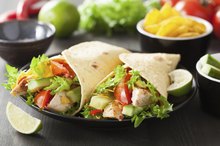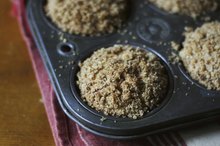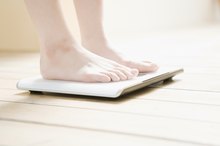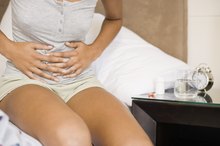Diet for Malabsorption
You might need to follow a diet for malabsorption if you have had surgery to either your stomach or small intestine, suffer from pancreatic insufficiency or have an inflamed bowel caused by a chronic disease such as celiac disease or ulcerative colitis. The diet requires you to limit your intake of fiber, fat and lactose -- the sugar found in milk -- as well as other sugars in some cases.
Other foods might also need to be limited, depending on your degree of malabsorption and additional medical issues. The following is a basic guide, and you should consult your doctor or dietitian to help you design a plan based on your individual needs.
Diet Guidelines
The diet for malabsorption is meant to help decrease your diarrhea and improve your nutritional status. Eating small, frequent meals might improve tolerance and decrease diarrhea.
Limiting your intake of foods that exacerbate diarrhea can also help, including foods high in fat such as fried foods, high fat meats, gravies and rich desserts, and foods high in fiber such as fresh fruits and vegetables, whole grains and legumes.
The lactose in milk and other dairy products can also cause diarrhea and should be avoided.
Concentrated sweets, such as soda, sugar and sweet desserts, might also be a problem and should be avoided or limited depending on your tolerance. It is also recommended that you drink liquids between meals.
- The diet for malabsorption is meant to help decrease your diarrhea and improve your nutritional status.
- The lactose in milk and other dairy products can also cause diarrhea and should be avoided.
Grains
The Microscopic Colitis Diet
Learn More
Grains provide your body with calories, energy and B vitamins. All of your grain choices should be made from refined flours to reduce fiber and roughage. Good choices include white bread, white rice, white pasta and refined ready-to-eat cereals such as corn flakes, farina and saltine crackers.
Fruits
Fruits are an important source of nutrients in your diet, especially potassium. Chronic diarrhea causes your body to lose a lot of potassium, making it important that you get adequate intakes from your diet.
Fruits are also a source of fiber, so you need to be careful of your choices. Good fruit choices for malabsorption include ripe bananas, canned or cooked fruits without skins or seeds, and diluted juice.
- Fruits are an important source of nutrients in your diet, especially potassium.
- Chronic diarrhea causes your body to lose a lot of potassium, making it important that you get adequate intakes from your diet.
Vegetables
Colitis Diet Foods to Avoid
Learn More
Vegetables are also a good source of potassium -- and like fruits, a source of fiber. Good choices include cooked or canned green beans, carrots, potatoes without the skin, beets, spinach, squash, mushrooms, asparagus and peas. Chronic diarrhea also causes your body to lose a lot of sodium. Vegetable juices are high in potassium and sodium, and can help you replace your losses.
- Vegetables are also a good source of potassium -- and like fruits, a source of fiber.
- Vegetable juices are high in potassium and sodium, and can help you replace your losses.
Protein
Your body needs an adequate intake of protein to support immune health and lean body mass.
Good choices on your diet include lean, tender or ground meats such as poultry, veal, pork, beef or fish. Eggs are also a good source of protein and usually are well tolerated, along with creamy peanut butter.
Dairy Foods
Dairy foods provide your body with calcium for bone health.
However, you need to be careful about your choices to limit your intake of lactose. Include lactose-free, low-fat or nonfat milk, small amounts of cottage cheese, cream cheese and yogurt without fruit or nuts.
Added Fats
Added fats provide calories, but you need to limit your intake to four to six servings a day to help limit malabsorption. Healthy fats and serving sizes include 1 tsp. of butter, margarine or oil; 1 tbsp.
of low-fat mayonnaise; 1 tbsp. of salad dressing; 2 tbsp.
of low-fat salad dressing; or 1 tbsp. of gravy.
- Added fats provide calories, but you need to limit your intake to four to six servings a day to help limit malabsorption.
- of low-fat mayonnaise; 1 tbsp.
Related Articles
References
- Ohio State University Medical Center: Malabsorption Diet
- "Krause's Food, Nutrition and Diet Therapy"; L. Kathleen Mahan et al.; 1996
- Hatchette TF, Farina D. Infectious diarrhea: when to test and when to treat. CMAJ. 2011;183(3):339-44. doi:10.1503/cmaj.091495
- Robert Steffen, Klaus Gyr, Diet in the Treatment of Diarrhea: From Tradition to Evidence, Clinical Infectious Diseases, Volume 39, Issue 4, 15 August 2004, Pages 472–473, doi:10.1086/422328
- Mäkinen KK. Gastrointestinal Disturbances Associated with the Consumption of Sugar Alcohols with Special Consideration of Xylitol: Scientific Review and Instructions for Dentists and Other Health-Care Professionals. Int J Dent. 2016;2016:5967907. doi:10.1155/2016/5967907
- Zodpey S, Deshpande S, Ughade S, Hinge A, Shrikhande S. Risk factors for development of dehydration in children aged under five who have acute watery diarrhoea. Public Health. 1998;112(4):233-236. doi:10.1016/s0033-3506(98)00238-8
- Gould M, Sellin JH. Diabetic diarrhea. Curr Gastroenterol Rep. 2009;11(5):354-9.
- Nyachuba DG. Foodborne illness: is it on the rise? Nutr Rev. 2010;68(5):257-69. doi:10.1111/j.1753-4887.2010.00286.x
- Appendix 7. Nutritional Goals for Age-Sex Groups Based on Dietary Reference Intakes and Dietary Guidelines Recommendations - 2015-2020 Dietary Guidelines - health.gov. Health.gov. https://health.gov/dietaryguidelines/2015/guidelines/appendix-7/. Published 2015.
- Barr W, Smith A. Acute Diarrhea in Adults. American Family Physician. 2014;89(3):180-189.
- Hartman S, Brown E, Loomis E, Holly Ann Russell. Gastroenteritis in Children. American Family Physician. 2019;99(3):159-165.
- Murao S, Hosokawa H. Serotonin 5-HT3 Receptor Antagonist for Treatment of Severe Diabetic Diarrhea. Diabetes Care. 2010;33(3):e38-e38. doi:10.2337/dc09-2131
- National Institute of Diabetes and Digestive and Kidney Diseases. Eating, Diet, & Nutrition for Diarrhea. Published July 2019.
- Steffen R, Gyr K. Diet in the Treatment of Diarrhea: From Tradition to Evidence. Clinical Infectious Diseases. 2004;39(4):472-473. doi:10.1086/422328
Writer Bio
Jill Corleone is a registered dietitian and health coach who has been writing and lecturing on diet and health for more than 15 years. Her work has been featured on the Huffington Post, Diabetes Self-Management and in the book "Noninvasive Mechanical Ventilation," edited by John R. Bach, M.D. Corleone holds a Bachelor of Science in nutrition.









